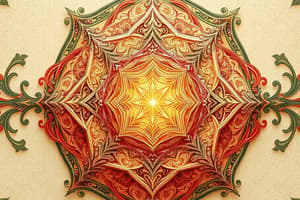Podcast
Questions and Answers
What is the main characteristic of a rigid transformation?
What is the main characteristic of a rigid transformation?
- It distorts the shape of the figure.
- It flips the figure upside down.
- It preserves the shape and size of the figure. (correct)
- It changes the size of the figure.
In a reflection, the figure is distorted over the line of reflection.
In a reflection, the figure is distorted over the line of reflection.
False (B)
What is the center of rotation in a rotation transformation?
What is the center of rotation in a rotation transformation?
The fixed point around which the figure turns.
A translation moves every point of a figure the same distance in the same ______.
A translation moves every point of a figure the same distance in the same ______.
Match the types of rigid transformations to their definitions:
Match the types of rigid transformations to their definitions:
Flashcards are hidden until you start studying
Study Notes
Rigid Transformations
- Rigid transformations preserve the shape and size of figures, preventing distortion.
- Distances between points and angles remain unchanged during rigid transformations.
Types of Rigid Transformations
-
Translation
- Moves every point of a figure the same distance in a specific direction.
- The shape and orientation of the figure remain constant; only the position changes.
- Example: Translating a triangle 3 units right and 2 units up shifts all points equally.
-
Rotation
- Rotates a figure around a fixed point, known as the center of rotation, by a specified angle.
- Distances from the center of rotation to all points on the figure remain the same.
- Example: A square rotated 90° clockwise around its center maintains congruency to its original position.
-
Reflection
- Flips a figure over a line, referred to as the line of reflection.
- Creates a mirror image of the figure, with each point having a corresponding point on the opposite side of the line.
- Example: Reflecting a pentagon over the y-axis results in each point moving to an equal distance on the opposite side of the axis.
Studying That Suits You
Use AI to generate personalized quizzes and flashcards to suit your learning preferences.




